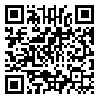1. Lobo V, Patil A, Phatak A, Chandra N. Free radicals, antioxidants and functional foods: Impact on human health. Pharmacogn Rev 2010;4(8):118-26. [
DOI:10.4103/0973-7847.70902]
2. Ames BN, Shigenaga MK, Hagen TM. Oxidants, antioxidants, and the degenerative diseases of aging. Proc Natl Acad Sci U S A 1993;90(17):7915-22. [
DOI:10.1073/pnas.90.17.7915]
3. Halliwell B, Gutteridge JM, Cross CE. Free radicals, antioxidants, and human disease: where are we now? J Lab Clin Med 1992;119(6):598-620.
4. Zhang PY, Xu X, Li XC. Cardiovascular diseases: oxidative damage and antioxidant protection. Eur Rev Med Pharmacol Sci. 2014;18(20):3091-6.
5. Pham-Huy LA, He H, Pham-Huy C. Free radicals, antioxidants in disease and health. Int J Biomed Sci 2008;4(2):89-96.
6. Jain AK, Mehra NK, Swarnakar NK. Role of Antioxidants for the Treatment of Cardiovascular Diseases: Challenges and Opportunities. Curr Pharm Des. 2015;21(30):4441-55. [
DOI:10.2174/1381612821666150803151758]
7. Boeing H, Bechthold A, Bub A, Ellinger S, Haller D, Kroke A, et al. Critical review: vegetables and fruit in the prevention of chronic diseases. Eur J Nutr 2012;51(6):637-63. [
DOI:10.1007/s00394-012-0380-y]
8. Wang X, Ouyang Y, Liu J, Zhu M, Zhao G, Bao W, et al. Fruit and vegetable consumption and mortality from all causes, cardiovascular disease, and cancer: systematic review and dose-response meta-analysis of prospective cohort studies. BMJ 2014;349:g4490. [
DOI:10.1136/bmj.g4490]
9. Nkambo W, Anyama NG, Onegi B. In vivo hypoglycemic effect of methanolic fruit extract of Momordica charantia L. Afr Health Sci 2013;13(4):933-9. [
DOI:10.4314/ahs.v13i4.11]
10. Campanella L, Bonanni A, Bellantoni D, Favero G, Tomassetti M. Comparison of fluorimetric, voltammetric and biosensor methods for the determination of total antioxidant capacity of drug products containing acetylsalicylic acid. J Pharm Biomed Anal 2004;36(1):91-9. [
DOI:10.1016/j.jpba.2004.06.002]
11. Apak R, Guclu K, Ozyurek M, Karademir SE, Altun M. Total antioxidant capacity assay of human serum using copper(II)-neocuproine as chromogenic oxidant: the CUPRAC method. Free Radic Res 2005;39(9):949- 61. [
DOI:10.1080/10715760500210145]
12. Cao G, Prior RL. Comparison of different analytical methods for assessing total antioxidant capacity of human serum. Clin Chem 1998;44(6 Pt 1):1309-15.
13. Chapple IL, Mason GI, Garner I, Matthews JB, Thorpe GH, Maxwell SR, et al. Enhanced chemiluminescent assay for measuring the total antioxidant capacity of serum, saliva and crevicular fluid. Ann Clin Biochem 1997;34 (Pt 4):412-21. [
DOI:10.1177/000456329703400413]
14. Aranda A, Sequedo L, Tolosa L, Quintas G, Burello E, Castell JV, et al. Dichloro-dihydro-fluorescein diacetate (DCFH-DA) assay: a quantitative method for oxidative stress assessment of nanoparticle-treated cells. Toxicol In Vitro 2013;27(2):954-63. [
DOI:10.1016/j.tiv.2013.01.016]
15. McCormack D, McFadden D. A review of pterostilbene antioxidant activity and disease modification. Oxid Med Cell Longev 2013;2013:575482. [
DOI:10.1155/2013/575482]
16. Jayawardena N, Watawana MI, Waisundara VY. Evaluation of the total antioxidant capacity, polyphenol contents and starch hydrolase inhibitory activity of ten edible plants in an in vitro model of digestion. Plant Foods Hum Nutr 2015;70(1):71-6. [
DOI:10.1007/s11130-014-0463-4]
17. Shomali S, Avval FZ, Boostani R, Jarahi L, Youssefi M. Serum total antioxidant capacity status of HTLV-1 infected patients. Acta Virol 2015;59(2):199-203. [
DOI:10.4149/av_2015_02_199]
18. Chang CC, Lee CT, Lan TH, Ju PC, Hsieh YH, Lai TJ. Effects of antidepressant treatment on total antioxidant capacity and free radical levels in patients with major depressive disorder. Psychiatry Res 2015;230(2):575-80. [
DOI:10.1016/j.psychres.2015.10.006]
19. Ziyatdinova GK, Budnikov HC, Pogorel'tzev VI. Electrochemical determination of the total antioxidant capacity of human plasma. Anal Bioanal Chem 2005;381(8):1546-51. [
DOI:10.1007/s00216-005-3132-5]
20. Wayner DD, Burton GW, Ingold KU, Locke S. Quantitative measurement of the total, peroxyl radical- trapping antioxidant capability of human blood plasma by controlled peroxidation. The important contribution made by plasma proteins. FEBS lett 1985;187(1):33-7. [
DOI:10.1016/0014-5793(85)81208-4]
21. Gaboriau F, Delcros JG, Moulinoux JP. A simple assay for the measurement of plasma antioxidant status using spontaneous autoxidation of homovanillic acid. J Pharmacol Toxicol Methods 2002;47(1):33-43. [
DOI:10.1016/S1056-8719(02)00187-9]
22. Cao G, Prior RL. Measurement of oxygen radical absorbance capacity in biological samples. Methods Enzymol 1999;299:50-62. [
DOI:10.1016/S0076-6879(99)99008-0]







